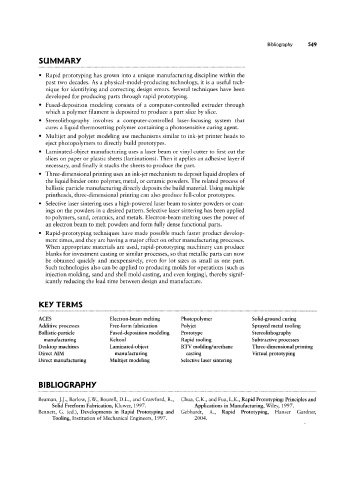Page 569 - 04. Subyek Engineering Materials - Manufacturing, Engineering and Technology SI 6th Edition - Serope Kalpakjian, Stephen Schmid (2009)
P. 569
Bibliography 549
SUMMARY
Rapid prototyping has grown into a unique manufacturing discipline within the
past two decades. As a physical-model-producing technology, it is a useful tech-
nique for identifying and correcting design errors. Several techniques have been
developed for producing parts through rapid prototyping.
Fused-deposition modeling consists of a computer-controlled extruder through
which a polymer filament is deposited to produce a part slice by slice.
Stereolithography involves a computer-controlled laser-focusing system that
cures a liquid thermosetting polymer containing a photosensitive curing agent.
Multijet and polyjet modeling use mechanisms similar to ink-jet printer heads to
eject photopolymers to directly build prototypes.
Laminated-object manufacturing uses a laser beam or vinyl cutter to first cut the
slices on paper or plastic sheets (laminations). Then it applies an adhesive layer if
necessary, and finally it stacks the sheets to produce the part.
Three-dimensional printing uses an ink-jet mechanism to deposit liquid droplets of
the liquid binder onto polymer, metal, or ceramic powders. The related process of
ballistic particle manufacturing directly deposits the build material. Using multiple
printheads, three-dimensional printing can also produce full-color prototypes.
Selective laser sintering uses a high-powered laser beam to sinter powders or coat-
ings on the powders in a desired pattern. Selective laser sintering has been applied
to polymers, sand, ceramics, and metals. Electron-beam melting uses the power of
an electron beam to melt powders and form fully dense functional parts.
Rapid-prototyping techniques have made possible much faster product develop-
ment times, and they are having a major effect on other manufacturing processes.
When appropriate materials are used, rapid-prototyping machinery can produce
blanks for investment casting or similar processes, so that metallic parts can now
be obtained quickly and inexpensively, even for lot sizes as small as one part.
Such technologies also can be applied to producing molds for operations (such as
injection molding, sand and shell mold casting, and even forging), thereby signif-
icantly reducing the lead time between design and manufacture.
KEY TE RMS
ACES Electron-beam melting Photopolymer Solid-ground curing
Additive processes Free-form fabrication Polyjet Sprayed metal tooling
Ballistic-particle Fused-deposition modeling Prototype Stereolithography
manufacturing Keltool Rapid tooling Subtractive processes
Desktop machines Laminated-object RTV molding/urethane Three-dimensional printing
Direct AIM manufacturing casting Virtual prototyping
Direct manufacturing Multijet modeling Selective laser sintering
BIBLIOGRAPHY
Beaman, ].]., Barlow, ].W, Bourell, D.L., and Crawford, R., Chua, C.K., and Fua, L.K., Rapid Prototyping: Principles and
Solid Freeform Fabrication, Kluwer, 1997. Applications in Manufacturing, Wiley, 1997.
Bennett, G. (ed.), Developments in Rapid Prototyping and Gebhardt, A., Rapid Prototyping, I-Ianser Gardner
Tooling, Institution of Mechanical Engineers, 1997. 2004.

